

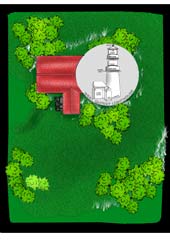
West Quoddy Lighthouse - $$4.95
The distinctive daymark pattern of West Quoddy Head Lighthouse has made it one of the county's best-known lighthouses. Situated at the easternmost point of the continental United States, this famous light helps steer vessels through the Bay of Fundy. The first light of day for the entire USA is seen from the top of this lighthouse.
West Quoddy Light House, West Quoddy, Maine
 Cape Flattery Light in extreme northwestern Washington Pacific seaboard is to the West Quoddy Head Lighthouse in extreme North Eastern Atlantic Coast-the most remote station on the wildest outskirts of that coast. The distinctive daymark pattern of West Quoddy Head Lighthouse has made it one of the county's best-known lighthouses. Situated at the easternmost point of the continental United States, this famous light helps steer vessels through the Bay of Fundy.
Cape Flattery Light in extreme northwestern Washington Pacific seaboard is to the West Quoddy Head Lighthouse in extreme North Eastern Atlantic Coast-the most remote station on the wildest outskirts of that coast. The distinctive daymark pattern of West Quoddy Head Lighthouse has made it one of the county's best-known lighthouses. Situated at the easternmost point of the continental United States, this famous light helps steer vessels through the Bay of Fundy.It's one of America's most popular and a favorite place for artists and harp players. Red stripes on American lighthouses generally signal that the tower stands to the right of an important harbor; black stripes mean it is located on the left side. A significant danger arises if the helmsman is color blind.
What people say...
This fantastic model was made by Graham Dixey of Harrow, England. Thanks Graham for sending us a picture!
A nice model that a beginner could easily put together. There is a problem getting the round tower and the square building to sit flat on a surface once assembled, but gluing it to a cardboard base would solve that difficulty. A beginner could enjoy this model, even if it involves butting up round and square parts. - Alan Wheeler
West Quoddy Light House
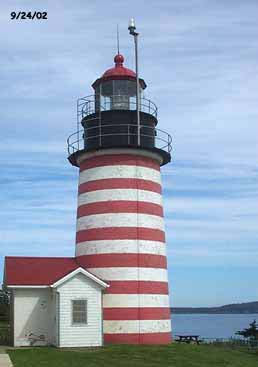
West Quoddy Head is a thickly wooded peninsula connected to Lubec, Maine, by a small strip of land. The lighthouse stands on the eastern end of the island. Indeed, despite its name, the light stands at the easternmost point of the United States (longitude 66', 57'West); its Canadian neighbor Head Harbor (East Quoddy) accounts for the apparent misnomer.
President Thomas Jefferson gave the order for construction, and in 1808 Thomas Dexter lit the first wicks in the lanterns, go feet above sea level. Overlooking Quoddy Narrows, which separates the United States from Canada, West Quoddy Light played an important role in aiding mariners stranded in thick banks of fog in the Bay of Fundy, between New Brunswick and Nova Scotia. A 500-pound bell,the first to be used as a fog signal in the United States, was installed in 1820.
The lighthouse was pulled down and reconstructed in 1858. The new tower rose to 85 feet above sea level and was equipped with a third-order Fresnel lens, which displays a pair of two-second flashes four times per minute. The handsome candy-cane stripes on the lighthouse (eight red and seven white) make for easy identification. Standing at the lighthouse, the visitor can look east to Roosevelt Campobello International Park and south to Canada's Grand Manan Island.
The Importance of Daymarks:To make lighthouses more recognizable by day, the Lighthouse Board introduced the concept of painting coastal towers in distinctive colors or patterns. Red stripes on American lighthouses generally signal that the tower stands to the right of an important harbor; blue or black stripes mean it is located on the left side. Many towers are painted white, but to enhance visibility in northern regions where snow may supply unwanted camouflage, a contrasting stripe is often added. To this end, vivid red accents appear on a number of lighthouses in northern Maine and eastern Canada, such as West Quoddy Head on the Maine coast, New Brunswick's Head Harbor Light, Prince Edward islands Cove, and Nova Scotia's Peggy's Cove. Combinations of black and white in a wide array of patterning distinguish various towers, particularly in the southeastern United States, including North Carolina's Cape Hatteras, Cape Lookout, and Bodie Island; Virginia Beach's Cape Henry, and Florida's St. Augustine and Cape Canaveral.
The striking diamond pattern added to Cape Lookout in 1873 even inspired a local community to name itself Diamond City.
Established in 1808, the West Quoddy Head Light is one of the nation's oldest and most revered lighthouses. For nearly two centuries it has lit the often stormy channel between the United States and Canada. The West Quoddy Light is located on a point of land known as West Quoddy Head, just across the long blue-gray channel from the southern shores of the Canadian province of New Brunswick. The original West Quoddy Light, built of local stone, was dismantled in 1857 and replaced the following year with a 45-foot brick tower. At the same time, it was outfitted with a Fresnel lens. With its distinctive red and white markings,the tower stands out like a big candy cane.
Although West Quoddy Head Lighthouse is remote, it is easily visited as is its part of the State Park. There are lots of lovely nature trails and panoramic views of the channel. For those of you who are sensitive, beware, this lighthouse is known to be haunted!

|

|
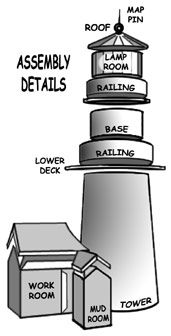




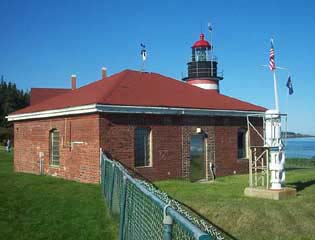
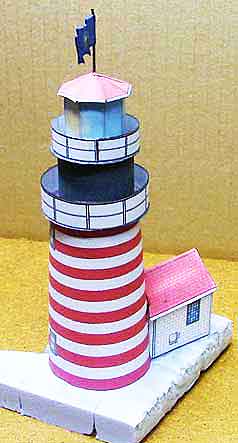 Thank You Ed Banke! |
and Dennis Brooks too! 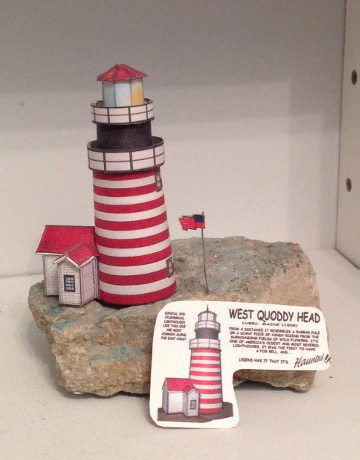 Here is a two inch tall version of the lighthouse. |
Addition information provided by AI
I found some more information about Lubec and the West Quoddy Head lighthouse. According to the town's website, Lubec is known as the "sunrise town" because it is the first place in the United States to see the sun rise each day. The West Quoddy Head lighthouse is one of the most popular attractions in Lubec, drawing more than 26,000 visitors each year.
Chasing Maine: First light at West Quoddy Head Lighthouse in Lubec


